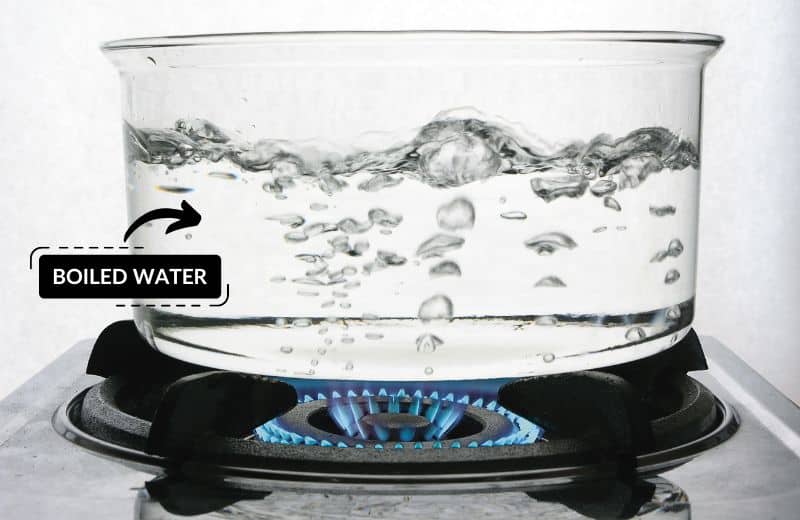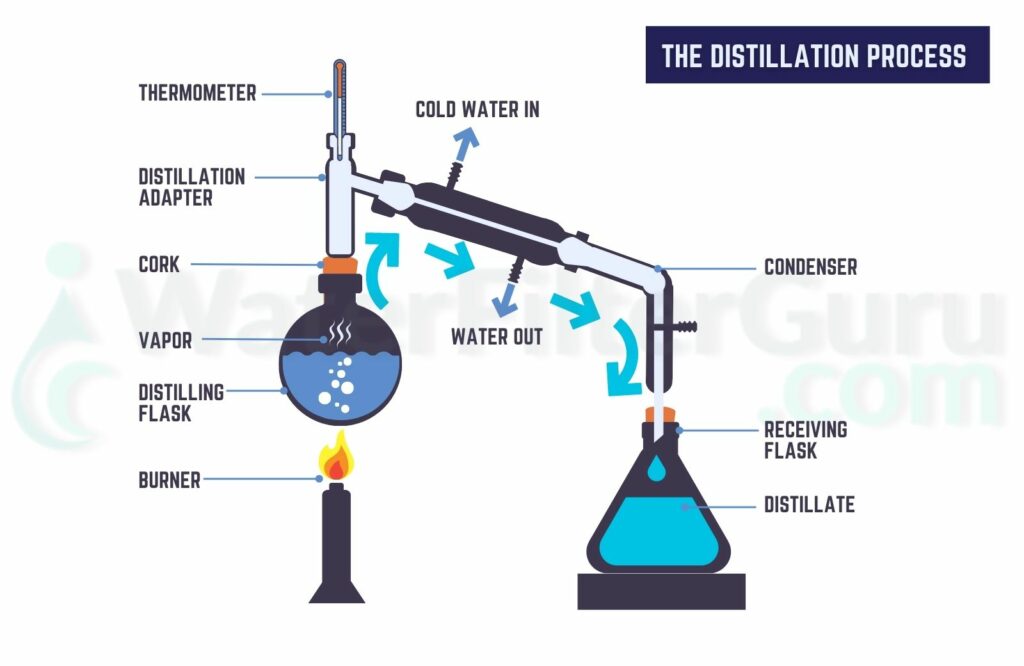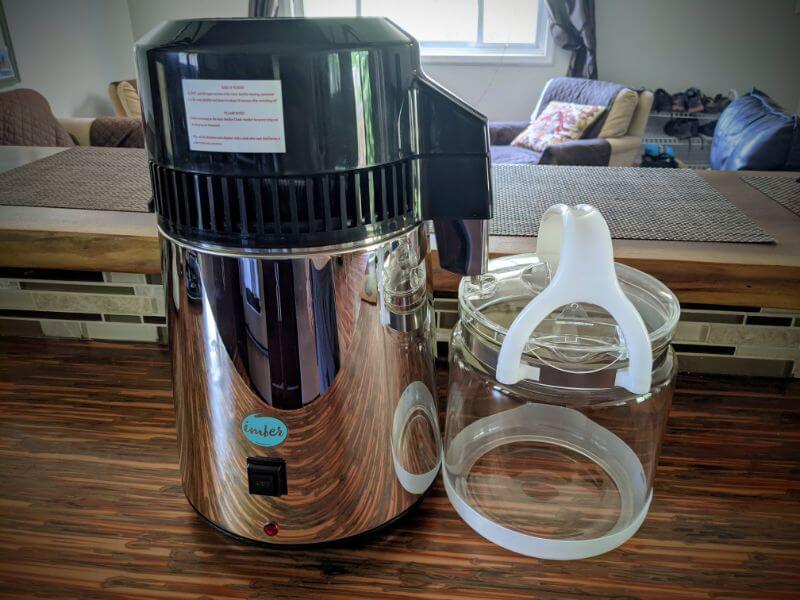Buying distilled water may feel like a chore when you have access to as much clean drinking water that you could want. If you need distilled water for a steam iron, aquarium, car cooling system, or anything else at home, you might be wondering whether simply boiling your water is a good enough alternative.
The answer, unfortunately, is no. Boiling water is nowhere near as thorough as the distillation process. If you need your water to be as pure, clean and contaminant-free as possible, it will be necessary to distill it.
In this guide, I’ll be looking at the key differences between boiled and distilled water, and answering your frequently asked questions on the subject.
Table of Contents
🧐 What’s the Difference Between Boiled Water vs Distilled Water?
If you’re just looking for the short answer, the difference between boiled and distilled water is that boiled water is simply heated until it reaches boiling point, while distilled water is boiled until it evaporates into steam, then condenses into a separate container. Distilled water is cleaner and purer than boiled water.
To help you to understand the numerous differences between boiled water and distilled water, I’ll be discussing three categories: the process, contaminants removed, and uses of the finished product.
Boiled Water
Boiled water is not purified water. While boiled water may still contain chemicals, metals and other dissolved solids, the boiling process can remove certain microorganisms.
The Process
Boiling water is exactly how it sounds: a heat source is used to raise the temperature of water until it reaches boiling point.
It’s easiest to boil tap water in a pot or pan on the stove. Put the heat on high, then wait until the water begins to bubble. This is a sign that it has hit boiling point. You will also hear the water bubbling.

Bring the water to a rolling boil – i.e. keep it bubbling – for a minute. If you’re boiling water at elevations above 6,500 feet, leave it for at least three minutes.
Once you have boiled your water, it’ll be safe to drink (if your purpose was solely to kill microorganisms – more on this below). Remove the water from the heat, then wait for it to cool before drinking. Store the water in clean, sealed containers until you plan to drink it.
Contaminants Removed
Boiling water is typically recommended if there’s a chance that your tap water source has been contaminated with microbiological impurities, like bacteria, viruses and protozoa.
Boiling water ensures that water reaches or exceeds the temperature of 100 degrees Celsius. You can rapidly kill bacteria when exposing them to temperatures above 65 degrees Celsius, so boiling water should almost certainly kill these microorganisms.
If your tap water contains minerals, salts, or other impurities, like heavy metals and chemicals, boiling water won’t remove these. In fact, boiled water tends to be slightly more saturated with these impurities, as some of the water will evaporate, while the same amount of impurities will remain.
Boiled Water Uses
Boiled water shouldn’t be used in place of distilled water for fish tanks, steam irons and so on. However, if you need to treat potential microbiological contamination in a water source before drinking, boiling your water is a viable option.
You may boil your water on a camping or hiking trip if you only have access to rivers, lakes, and other groundwater sources.
You could also need to boil your tap water if your local water system becomes contaminated. Your town or city will issue a boil water notice or advisory if there is a leak or break in a local water line, or if contamination has been detected.
Distilled Water
Distilled water is almost completely pure. It contains no dissolved solids, including salts, chemicals, microorganisms, and metals.
The Process
To distill water, a distiller must be used. Distillers are complex appliances that allow for water to be boiled and condensed within a single unit.
To make distilled water, water is added to a boiling chamber. The system is switched on, and the water is heated to boiling. It evaporates into steam and passes along a corridor, where it is cooled and condensed back into liquid water droplets. These droplets then leave the distiller and collect in a clean container.

During this process, impurities that are unable to evaporate and condense into a liquid are left behind in the boiling chamber. Any impurities that can evaporate and condense are filtered out at the last stage of distillation, when water is leaving the spout. A carbon filter is typically used for this job. The thoroughness of the distillation process results in almost entirely purified water.
While boiling water takes just minutes, the distillation process takes a lot longer. Typically, it takes up to 6 hours for an at-home water distiller to produce a single gallon of distilled water.
Contaminants Removed
If you want to turn your tap water into pure water, you should use a distiller. This process removes nuisance particles like hardness and iron, inorganic compounds like nitrate and lead, chemicals like chlorine, minerals, salts, and much more. The boiling process also kills microorganisms like bacteria and protozoa.
It’s easier to look at what distillation might not remove. This process isn’t effective in removing all chemicals, which is why a carbon filter is typically used as a final filtration stage. This ensures that all chlorine, chloramines, pesticides, herbicides, and other chemicals are removed from water.
Distilled Water Uses
You can use distilled water for watering your plants, adding to your fish tank, topping up your steam iron, and much more.
Many manufacturers use distilled water, such as those in the cosmetics and automotive industries. The pharma industry also uses distilled water in water-based products that need to be introduced directly into the bloodstream.
Distilled water can also be used for drinking. Keep in mind, though, that you may find that distilled drinking water has a “flat” taste because its minerals have been removed. You can reintroduce healthy minerals into your distilled water using trace mineral drops.
Related: Difference between boiled and filtered water
🧠 Frequently Asked Questions
Is it bad that distilled water contains no minerals?
No. The minerals you get from your tap water are limited as it is. Most of our minerals come from food. As long as you’re getting plenty of calcium, magnesium and potassium in your diet, you won’t miss out if you choose to switch to drinking purified distilled water.
Distilled water is purer than boiled water – but is it 100% pure?
It’s as close to pure as you can get. It wouldn’t be scientifically accurate to say that distilled water is 100% pure, as it does contain minute traces of some impurities. However, in most cases, a distiller can produce water that is at least 99.9% pure.
What if I boil my water in a stove-top pot with a filter?
If you’re using an appliance with a filter to boil your water, it’s still not the same as using a distiller. Boiling the water will kill any microorganisms, and the filter might remove a few select impurities, like chlorine, when you pour water from the spout. However, your water will still contain a number of trace impurities that can only be completely removed in the distillation process.
Where can I buy distilled water?
Most supermarkets sell bottles of distilled water. You can also buy distilled water online in marketplaces like Amazon. However, if you plan to buy a lot of distilled water, it may be cheaper in the long run to make your own (see below).
Can I make distilled water at home?
Yes. You can either buy a water distiller – which I’d recommend if you need distilled water on a regular basis – or you can make your own distiller using several pots and your kitchen stove.
To make your own distiller, place a small pot inside a large one. Fill the large pot with water, making sure the water doesn’t spill over into the small pot. Put the pot on a high heat on your stove and place an upside-down lid on top.
When water reaches boiling point, it will evaporate and form steam. This water vapor will rise, before hitting the upside-down lid. The relative coolness of the lid will cause the water to condense back into water droplets, and it will run down to the inside of the lid and drip into the small pot.
As you can imagine, this is a lengthy process, and requires some level of commitment from you. Using an at-home distiller is much simpler, as you can simply fill the boiling chamber and let the system get on with it.

Is rainwater distilled?
Rainwater is technically distilled, as it is produced by a natural distillation process. Heat from the sun causes water to evaporate and rise into the atmosphere, where it cools and condenses, forming tiny water droplets that make clouds. Eventually, these clouds release the water in the form of rain.
On its way down to earth, rainwater will come into contact with a number of airborne pollutants, which means that it won’t be as pure as manmade distilled water once it reaches the ground.
What is the pH of distilled water?
Distilled water has a pH of 7, which means that it’s neither acid or alkaline.
How do distillers compare to water filters?
Water filters are less effective than distillers, and tend to target specific groups of common impurities. Most water filters are incapable of producing purified water. Instead of boiling water, filters grab onto dissolved particles and prevent them from passing through the filter media with the water particles. This method is known as filtration, not purification.

How about boiling rain water to remove impurities?
Boiling will disinfect the water to kill pathogens, but may just end up increasing concentrations of other contaminants like chemicals or metals that the water might have picked up from surfaces it touched when it fell